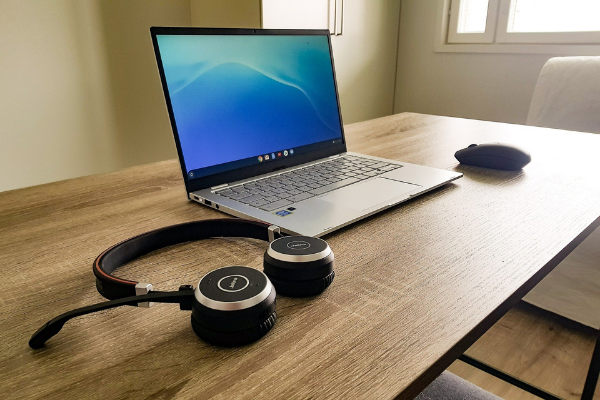Insights
INSIGHTS
All Topics
7 things you need for blended working
20 Oct 2020by Joe Lepper
From support on reopening offices post COVID-19, to help with security and Wi-Fi connections, we look at the 7 vital things charities need for blended working
Blended working arrangements were already increasing in popularity before the COVID-19 pandemic. But a comibination of more stringent social distancing measures, and the need to cut costs on property leases amid the pandemic, has made blended working a necessity for employers and employees alike.
What is blended working? Essentially it is an approach that combines the benefits of home and remote working in a flexible way. It may also be known as hybrid working.
Those working under such arrangements can work at home or the office at different times. This means offices can be smaller, cheaper to run and more sparsely populated. This can greatly help to maintain social distancing. Those working from home and the office can enjoy the best of both worlds, offering sociability and a better work life balance.
Digital tools have been key to this focus on blended working. Here we will explore 7 key things charities need for such flexible working arrangements.
Safe return to work tools
For many charities, the first route to blended working amid COVID-19 recovery is to reopen offices, albeit perhaps in smaller premises and with reduced staff.
This is where a tool such as Salesforce’s Work.com can help. This online platform has been designed for organisations to ensure they can open their offices after a long break safely. This includes access to guidance from leadership experts, latest health and COVID-19 data as well as how to apply track and tracing procedures to the workplace. It also offers emergency response management support.
Meanwhile, the Salesforce Workplace Command Centre provides a single hub to monitor a charity’s readiness to open. This allows charity leaders to manage employees’ emotional wellbeing and safety as they move between home and office.
Salesforce’s COVID19 Nonprofit Response Playbook is another useful return to work resource, offering a roadmap for charities to use as they reopen offices.
Virtual office space
Some charities have closed down their offices long term or are keeping them open only for limited periods. But staff may still need to attend workplaces under a blended working arrangement. This could be to collect and send post or arrange face-to-face meetings.
Virtual office space can be extremely useful, offering mail collection services as well as meeting rooms and other space hire, when charities need them. This offers charity staff an ideal way to work in digital and physical locations.
Among organisations to offer office services for blended working is CAN Mezzazine, which specialises in virtual office services to charities. Desk space, hot desking and hiring meeting rooms are available through its services.
VPN
Staff working across locations can add to a charity’s security risks.
The primary problem is when in order to get access to computer systems such as an intranet or customer relationship management (CRM) system, staff have to make a connection to the charity network via the internet, which is a public network and not designed to be secure.
This can be overcome by staff gaining access to the office from home through a virtual private network (VPN).
A VPN is software that creates a secure connection between home and office computers. This is perfect for blended working as data using this connection is encrypted before it leaves a home computer and decrypted when it arrives at work.
Wi-Fi connectivity at home
There are a number of tools designed to make it easier for workers in a blended working arrangement to ensure working at home and the office is seamless and broadband connectivity is not a barrier to working remotely.
Some workers may struggle to get a decent mobile phone signal at home. This can be easily remedied with the use of Wi-Fi Calling. This is offered by all major UK mobile networks and allows your staff member’s handset to connect via an internet connection rather than a mobile phone mask. Calls and texts can be received as normal without interruption this way.
Another tool to make all the difference to home connectivity is a picocell, which is a small box charity workers can connect to their home internet router and acts as a local mobile phone tower. This ensures everywhere in the home can access a strong signal.
A mesh Wi-Fi system is another connectivity tool. This uses three or more small devices that can be placed around a home to boost internet connectivity.
KVM Switch
Often those in blended working arrangements are issued with a laptop to ensure they can work seamlessly between home and office.
But laptops can be limited for some workers, who prefer a larger monitor screen and separate keyboard. This is where a KVM Switch can help, which is an inexpensive device that lets employees switch between controlling their own desktop computer or charity’s laptop using the same keyboard, monitor or mouse. Among KVM Switch products is Ugreen USB KVM Switch and ieGeek KVM Switch, both of which cost under £20.
Video conferencing
Video conferencing is an obvious, but nevertheless important piece of kit for blended working arrangements that needs to be mentioned.
Zoom has become the go to product for many charities and the Charity Digital Exchange has a variety of discounts on one year subscriptions. This includes the pro plan and business plan bundle.
Workflow and Collaboration tools
The right tools can help you bring work timetables, task lists and messaging together in one place. This is perfect for blended working arrangements as staff move between home and the office.
Asana is among the most eye catching and is available at discounted rates in the Charity Digital Exchange. It allows employers to monitor and manage work and offers that vital one stop shop for workers in a variety of locations.
For trustees and senior management Passageways’ On Board is another collaboration and remote working tool to recommend for blended working arrangements. A 70% discount on an annual On Board Core subscription is available in the Charity Digital Exchange for this tool, which digitises and centralises board information and activities, including documents to sign.
Joe Lepper
More on this topic
Recommended Products
04 Jan 2025by Aidan Paterson
The best bank accounts for charities
03 Jan 2025by Ioan Marc Jones
The best UK charity text donation services
03 Jan 2025by Ioan Marc Jones
Converting one-time donors into life-long advocatesSponsored Article
Our Events
Charity Digital Academy
Our courses aim, in just three hours, to enhance soft skills and hard skills, boost your knowledge of finance and artificial intelligence, and supercharge your digital capabilities. Check out some of the incredible options by clicking here.


















